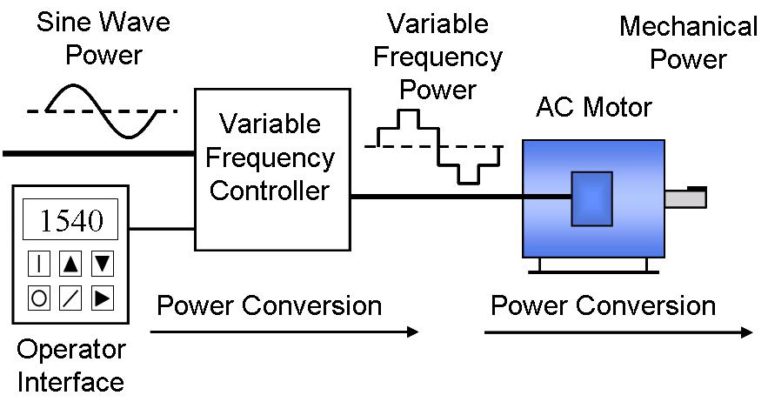Question: What is the difference between a phase converter and a “Variable Frequency Drive” Why would I choose one over the other?
Let’s first look at what defines each product…
Phase Converters
Generally phase converters are divided into three popular methods of control:
Static conversion techniques in which the motor is run at less than full efficiency mainly on two of the legs of the three-phase motor. Current is sometimes injected into the third leg with a capacitor or transformer arrangements that provide imperfect phase shift. In these systems the motor must be de-rated.
Rotary phase converters constructed from a three-phase electric motor or generator “idler”. These normally require some kind of starting aid and capacitors to improve phase balance and power factor. This is a two-motor solution. One motor is not connected to a load and produces the three-phase power, the second motor driving the load runs on the power produced.
A digital phase converter uses a rectifier and inverter to create a single voltage with power electronics, which is added to the two legs of the single-phase source to create three-phase power. Unlike a VFD, it cannot vary the frequency and motor speed. Since phase converters generate one leg that must match the voltage and frequency of the single-phase supply, it does have the advantage of a sine-wave output voltage and excellent voltage balance between the phases.
Benefits of using a Phase Converter
- Installation Simplicity (less wiring)
- Phase converters are the “Plug and Play” option for simple phase conversion
- Operating both Resistive & Inductive Loads
- Only generates three phase power
- Best option for a general type power conversion based on HP or AMP requirements
- Can be used for multiple machines to run at the same time.

Let’s now define “VFD” or “Variable Frequency Controller”, also sometimes termed “inverter”, “Freq. Drive”, etc…
This is where terms can be crossed. Also known adjustable-frequency drive, variable-speed drive, AC drive, or micro drive, a VFD is a type of adjustable-speed drive used in electro-mechanical drive systems to control AC motor speed and torque by varying motor input frequency and voltage
The VFD “Speed” controller is a solid state power electronics conversion system consisting of three distinct sub-systems: a rectifier bridge converter, a direct current (DC) link, and an inverter. Voltage Source inverter (VSI) drives are by far the most common type of drives. Most drives are AC-AC drives in that they convert AC line input to AC inverter output. There are other types, but this is the most common.

VFD Control Performance
AC drives are used to bring about process and quality improvements in industrial and commercial applications’ acceleration, flow, monitoring, pressure, speed, temperature, tension, and torque.This ease of control makes more complicated applications such as vertical mill, drill press, lathe, even a saw or air compressor the perfect fit for our selection of VFDs.
Fixed-speed loads subject the motor to a high starting torque and to current surges that are up to eight times the full-load current. AC drives instead gradually ramp the motor up to operating speed to lessen mechanical and electrical stress, reducing maintenance and repair costs, and extending the life of the motor and the driven equipment.
Variable-speed drives can also run a motor in specialized patterns to further minimize mechanical and electrical stress. Most VFD manufacturers produce drives that are 115V input capable up to 1 or 1.5HP rated and 208-240V 1 phase input capable up to 3 HP factory rated. If higher horsepower is needed, a VFD can be de-rated (oversized) to allow single phase input and still provide the horsepower rating. This will require your motor FLA rating and sometimes the S.F. (service factor) of the motor depending on the application.
Benefits of using a VFD
- Motor Speed Controller
- Phase conversion by-product
- Precision Frequency Control
- Soft Starting motors
- Energy Savings
- HVAC, Pumps, CNC, Wood Working, Conveyors, Mixers, Hoists, Cranes, Elevators for performance improvement.
- Building Automation Systems
When to use Phase Converter or use a VFD
So what about the difference in products? If you are trying just to connect a machine up for plug and play operation with minimal performance gain in a single phase to three phase conversion. Well your best solution for the above example is a “Phase Converter” since this is a general type power conversion based on HP or AMP requirements. This is best for refrigeration equipment, portable equipment on trailers, freezer’s etc. or when the machine has numerous low voltage controls and internally for the machines control panel.
VFD’S are very well suited , if you have a pump, vertical mill, drill press, lathe, even a saw or air compressor where not only phase conversion is desired, but the desire to control speed of that motor for fine tuning your application, then a VFD is your desired controller. Most VFD manufacturers produce drives that are 115V input capable up to 1 or 1.5HP rated, 208-240V 1 phase input capable up to 3 HP factory rated. If higher horsepower is needed a VFD can be de-rated (oversized) to allow single phase input and still provide the horsepower rating. This will require your motor FLA rating and sometimes the S.F. (service factor) of the motor depending on the application.
